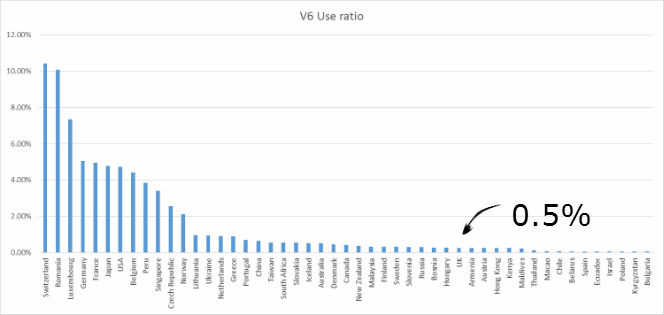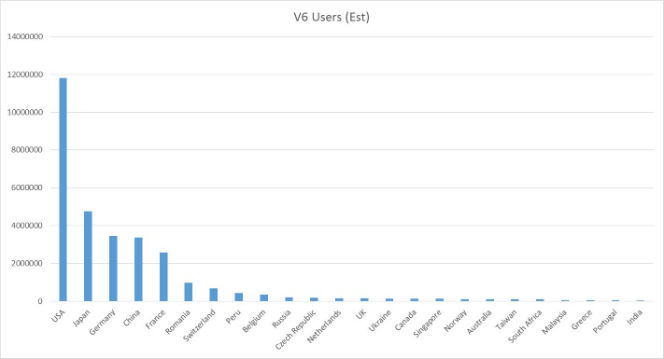 This graph of percentage IPv6 adoption by country as of today, 14th October 2013, was extracted from potaroo.net. It shows the percentage of internet users in each country using IPv6. You can get the exact numbers from potaroo. The UK’s 34th place suggests we are seriously lagging behind. OK we can look at it in terms of actual numbers of users – see the next chart below. We are 13th one this one but take a look at the top 5 – all major competitors in the global commercial stakes.
This graph of percentage IPv6 adoption by country as of today, 14th October 2013, was extracted from potaroo.net. It shows the percentage of internet users in each country using IPv6. You can get the exact numbers from potaroo. The UK’s 34th place suggests we are seriously lagging behind. OK we can look at it in terms of actual numbers of users – see the next chart below. We are 13th one this one but take a look at the top 5 – all major competitors in the global commercial stakes.
These charts don’t show us how IPv6 adoption is moving with time for each country but I don’t get the feeling it is proceeding with any pace here in the UK.
Whilst we are on the subject of UK competiveness it is also worth noting that the annual Cisco Visual Networking Index is forecasting an average global broadband speed of 39Mbps by 2017. Ofcom reports that in May 2013 the UK average broadband speed was 14.7Mbps. This does fit with the Cisco forecast but to keep up with the game there is a lot of work to do to hit the 2017 number.
The base technology roadmap is there in the UK – you can now get FTTP on demand at 330Mbps. It’s going to take ultra high def TV delivery over broadband to drive the market. I think we are still relatively early days in this space. Fibre To The Premises with a performance of 1Gbps and up is still the end game.


3 replies on “IPv6 usage in UK lagging behind our major global competitors”
Tref,
My own personal thoughts on this are we`ll see increased adoption when you can literally buy IPv6 broadband from one of the big 3 or 4.
We held a panel on this at UKNOF26 (videos due soon) with the expectation that major players will be in a position to offer this within 12-18 months. The pivotal point being the true and absolute exhaustion of IPv4.
Chris
how does potaroo measure this? is it announced space?
this is what they say on their site:
This data is generated by using the ISO 3166 economy code information provided in the allocation and assignment statistics reports as generated by the Regional Internet Registries. This code reflects the economy in which the entity to whom the allocation or assignment was made is located, but does not necessarily reflect the scope of use of deployment of the associated resource. Many Internet service networks have international components, and their numbering resources are often deployed across multiple economies. For this reason the report presented here does not accurately reflect the actual number resource distributions across these economies.